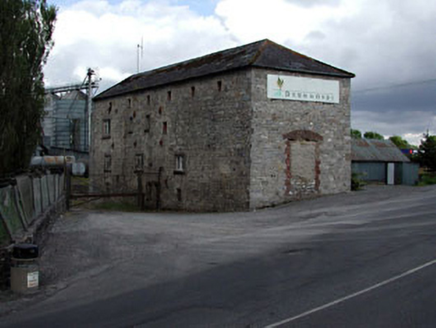Survey Data
Reg No
11810038
Rating
Regional
Categories of Special Interest
Architectural, Historical, Social
Original Use
Store/warehouse
Date
1820 - 1860
Coordinates
267376, 219272
Date Recorded
12/06/2002
Date Updated
--/--/--
Description
Detached six-bay four-storey rubble stone warehouse, c.1840, with single-bay four-storey side elevation to south-west originally having segmental-headed opening. Renovated, c.1970, with some openings remodelled. Now disused. Hipped roof with slate. Red clay ridge tiles. Cast-iron rainwater goods with sections of replacement aluminium rainwater goods, c.1970. Random rubble stone walls. Dressed stone quoins to corners. Square-headed window openings (most remodelled, c.1970). No sills (concrete sills, c.1970, to remodelled openings). Stone lintels. Rendered surrounds, c.1970, to remodelled openings. Remains of timber fittings to original openings. Replacement timber casement windows, c.1970, to remodelled openings. Remains of segmental-headed opening to south-west elevation. Red brick block-and-start surround with shallow red brick relieving arch over. Now blocked-up (rubble stone). Set perpendicular to road with side (south-west) elevation fronting on to road.
Appraisal
This warehouse is a fine and imposing rubble stone structure that acts as a prominent landmark from Market Square and the bridge to the north, and the Grand Canal and Rathangan Bridge to the south-west. Although renovated in the late twentieth century, including the remodelling of some openings, the building retains some of its early character and later alterations might be easily reversed. The construction of the building in rubble stone with red brick dressings is representative of the traditional method of building in the early nineteenth century, and early features and materials remain in situ, including the remains of timber fittings to openings to the top floor, together with a slate roof. The warehouse is of considerable social and historical importance, attesting to the early industrialisation of Rathangan in the late eighteenth/early nineteenth centuries following the establishment of the Grand Canal in the locality. The building, which is an important component of the architectural heritage of the town, is structurally sound and ideal for conversion to an alternative purpose.

